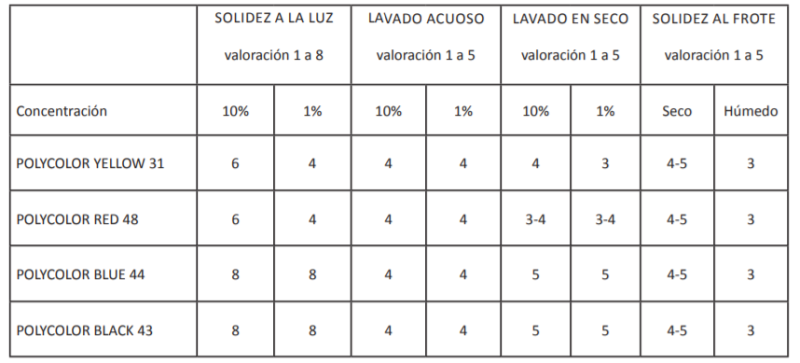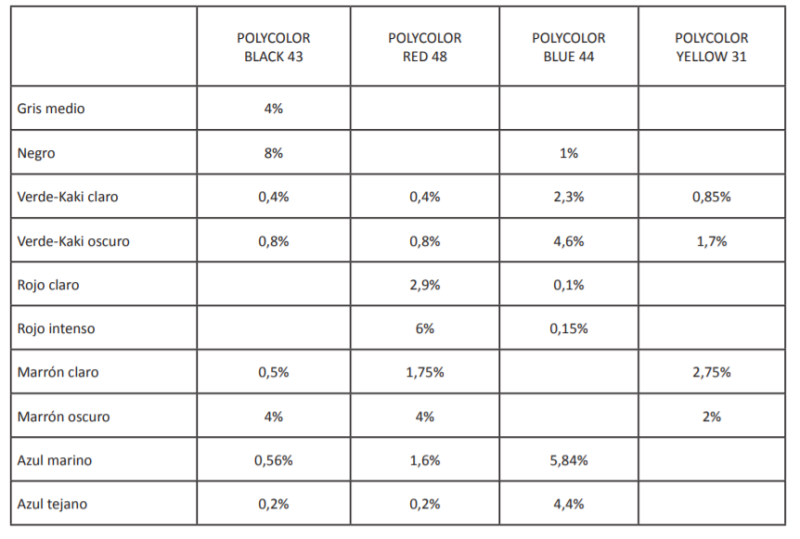Knowde Enhanced TDS
Identification & Functionality
- Carrier
- CASE Ingredients Functions
- Industrial Additives Functions
Features & Benefits
- Industrial Additives Features
- Features
The system is sensitive to
- Remains of anionic products from scouring or bleaching.
- Traces of alkali.
- Presence of electrolytes.
- Presence of carbonates and / or bicarbonates in the water.
- Short bath ratio, must be worked at a minimum R / B of 1:25
- Excessively hot water at the beginning of the process (above 30ºC).
- Presence of foam during the process.
- To the use of other auxiliaries than those recommended.
- Excessicve speed of the hydraulics (coil bath exchange) of the rope in jet (recommended 1 Cycle / min) or ofn the rotation of the Drum in Garment.
- Too rapid rise in temperature.
- Inadequate initial pH (excessively acid or alkali) must be started and kept neutral.
- System operation
- An Acrylic polymer of a cationic nature is used to block the fiber in a first stage so that the pigments cannot be access it.
- With the increase in temperature, the polyacrylate is unblocked and the access of the pigment to the fiber is slow and regular.
- The pigment used in this process is Cationic nature and consists of am amphotericinorganic color filler coated with cationic polyutherene copolymer.
- This protective layer due to the effect of temperature is deposited on the fiber and performs a presetting that allows the fabric to be manipulated and to make the final fixation in a padding, thus avoiding introducing other types of fixing resins into the dyeing apparatus.
- Brief explanation of the assistants employed
DYEWET - EP
This is a strongly anionic surfactant whose function is to lower the surface tension of the fiber so that it is more easily wettable by the subsequent pigment dye bath. With this treatment we manage to reduce, for example, the surface tension of the polyester, which is initially from 43-44 dynes / cm to 17-18 dynes / cm.
We do not improve the affinity of the fiber for the dye, since the affinity is given by the anionic character of the fiber itself, but rather that we facilitate the pigment to access the fiber more easily. Therefore, it is not the concept of affinity (electric charge +/-) that we are using with this pretreatment, but rather the concept of wettability (surface tension).
ADIDYE - EP
This is a flocculating agent that we use to keep the pigment perfectly dispersed in the dye bath. As the flocculants only work on the water in the dyeing bath, it also allows us to adjust the speed of pigment depletion on the fiber, since it acts as a retarder. For this reason, we suggest working in gr / L instead of%, since at different bath ratios the results are different. A lack of product causes the pigment to rise too quickly to the fiber and an excess of product makes the depletion too slow and the process too long. The optimal amount is 0.8 - 1 g / L, whatever the pigment concentration.
LEDIGAL - EP
It is a mixture of biodegradable solvent and glycols that already contain the pigments themselves. We only use it when problems are anticipated, whether they are due to the type of machine, type of water, etc. Normally it does not have to be used since the pigments are formulated in a balanced way to maintain a perfect dispersion in the bath and thus achieve a good leveling. This product only acts on the pigment dispersion, it does not act on the fiber or on the dyeing bath water.
ZEROFOAM - EP
The presence of foam in the process causes the pigment dispersion to be trapped in air bubbles and does not allow the pigment to deposit on the fiber, in addition, when these air bubbles explode, they push the pigment unevenly onto the fabric. producing stains. For this reason it is very important that there is no foam throughout the dyeing process.
It is better to work this product by excess than by default. If we put too much the only problem is that we delay the dyeing process, but if we put too little we will surely have a large amount of stains.
POLFLOW - EP
It is basically used in very thick fabrics that produce folds that are difficult to remove, both in rope dyeing and in garments (large size pants). The product acts on the fiber and for this reason an excess of it can make it difficult for the pigment to access the fiber. It is necessary to carry out preliminary tests on each fabric before standardizing a recipe for all articles. We believe that the maximum to be used is 2 gr / L and we suggest first testing at 1 gr / L and increasing little by little if necessary.
Applications & Uses
- Applications
- Compatible Polymers & Resins
- Compatible Substrates & Surfaces
- Coating Type
- Industrial Additives End Use
- Ink & Toner Type
Properties
- Color
- Physical Form
Technical Details & Test Data
- Pigment fastness table

- Orientative placement

- Basic recommendations of the Eco Pigment 2016 process
The colors used in this process are pigments, the non-fixation of these on the thread, fabric or garment creates staining problems, since these act as filter paper.
It is important to follow the following recommendations in order to achieve a perfect fixation of the pigment during the dyeing process, which are detailed below.
• Before being added, the colors and auxiliaries must be diluted in cold water at a ratio of 1/30 and slowly incorporated into the dyeing machine, taking care not to add them mixed (auxiliaries and colorants).
• It is necessary to filter the diluted pigment solution with a 200 mesh mesh or a fine fabric of similar construction, to avoid possible stains during the dyeing process, caused by dry particles of pigment from the utensils used in previous weighings or by remaining poorly closed container.
• Slowly dose the colors as indicated, so that a uniform absorption is produced (multiply by a factor 5 the% of color and this will give us the minimum times of its introduction: Ex. 6% of color x 5 = 30 minutes time of adding the colorant to the machine).
• The absorption of colors by the fabric is 25-50% of fiber weight per minute (depending on of the process and the fabric to be dyed). When the colors are added to the dyeing bath according to this absorption ratio, a clean and colorless resulting bath is obtained. Therefore, it is necessary to slowly dose the pigment into the system using the tint machine bucket. This part of the process has to be done at room temperature and kept for 10-15 minutes after finishing the introduction of the colorant.
• Colors have a stronger affinity relationship with increasing temperature, the higher the temperature, the higher the affinity. If the temperature is increased before the fabric completely absorbs the colors, they will set unevenly and coagulation of the pigment will occur and unevenness or spots will form on the fabric. That is why the colors have to be absorbed by the cold fabric in the highest possible percentage.
• To prepare the fabric we recommend as cold wash or a and a hot wash to remove any residual substance that would cause a non - uniform dyeing.
• It is important to start the dying process with hte fabric perfectly neutrilized. The presence of ersidual alkali may cause colored precipitates.
• In Jet / Soft machine dyeing, the speed must be 1 cycle / minute, (approximately 150 meters / min.), The higher the speed, the more foam it will form and this phenomenon will cause matching problems and staining.
• Always clean for overflow. The color bath that has not been fixed after dyeing, is eliminated by overflowing the cold machine, eliminating the possibility of stains caused by the remains of foam and unfixed pigment.- Eco Pigment 2016 process diagram

